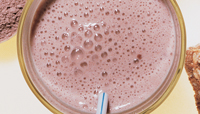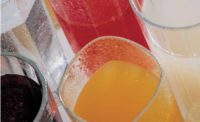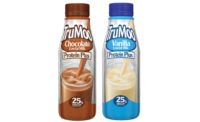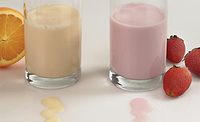As beverage-makers dream up new formulations to address the gamut of consumer requests, such as natural, diet, functional or indulgent products, new recipes often can spur the need for new solutions from ingredient suppliers. In response, hydrocolloid manufacturers have developed portfolios of binding ingredients that are able to perform in new applications. Jane Schulenburg, marketing director for Atlanta-based CP Kelco, summarizes that the removal of ingredients, such as sugar, is an opportunity for hydrocolloids; likewise, so is the addition of ingredients, including vitamins.
Exotic new flavors also can create opportunities for hydrocolloids, Schulenburg says. “The more unique flavors that people are trying to use, like guava and pomegranate and things like that, if they try to put those into certain beverages, they just don’t function,” she explains. “So our products are used as the enablers, really, to get those flavor profiles correct and for the beverage to have a decent drinking experience.”
Seeking cleanliness
Compounding the challenge of creating new formulations, hydrocolloid manufacturers highlight a growing trend toward clean labels.
“Beverage consumers have become very sophisticated — they are reading labels and are now more aware than ever of what they want going into beverages and what they want out,” says Dinah Diaz, market development manager for beverages and encapsulation with National Starch Food Innovation, Bridgewater, N.J.
National Starch, together with its parent company Corn Products International, Westchester, Ill., offers Q-Naturale, a natural clean label emulsifier derived from a Chilean tree. The ingredient is able to produce high oil emulsions to enable a small dosage of an ingredient to be used in the final product, which can minimize off-notes while delivering an appropriate amount of a given additive to qualify for a health claim, Diaz says.
In addition, Q-Naturale can be used to replace gum arabic, representing the possibility of 20 percent savings in standard applications, she says. Another cost-savings opportunity for Q-Naturale is its ability to be formulated in clear or alcohol beverages in which the natural emulsifier creates a stable beverage without the use of often costly weighing agents, Diaz explains.
Also among the clean label options are Germany-based company Gelita’s naturally sourced gelatin and collagen peptides. The company notes that the U.S. Department of Agriculture (USDA) cites gelatin, which can be used as a stabilizer, emulsifier and texturizer in beverage systems, as one of 38 ingredients that can be used in products that carry the USDA-certified organic label. As minor ingredients, gelatin and collagen peptides can comprise as much as 5 percent of an organic product, Gelita says.
Paying further attention to label requirements, last year the company introduced Geliko kosher gelatins that are certified kosher by the Orthodox Union (OU). This certification will allow manufacturers to produce kosher products that have the same attributes as non-kosher products, the company says. In addition, the kosher-certified ingredients offer new options to companies that currently use a blend of hydrocolloids, notes Mindi McKibbin, specialist of edible technical services for Gelita USA, Sergeant Bluff, Iowa.
Limiting undesirables
Calorie-counting consumers are placing pressures on formulators who are looking for options to decrease the waistline effect of beverages. CP Kelco’s Schulenburg notes that pectin often is used in carbonated beverages, but the company is looking into options for reduced-calorie carbonated applications. She notes that the reduction of sugar changes the mouthfeel qualities in these beverages, which can be remedied by the addition of hydrocolloids.
“If you want to make a diet version, a version that’s lightly carbonated or that uses artificial sweeteners, you can use some of our [hydrocolloids] that can give that back to the beverage,” Schulenburg says.
The company’s research has found many synergies between xanthan gum and artificial sweeteners, she explains. In particular, Schulenburg says that CP Kelco has found particular success with diet energy drinks and xanthan gum. With the popularity of the ingredient, the company is working to develop technologies that allow for a reduction in xanthan gum usage levels.
“We are coming up with some new products that are high-performance — cost is always an issue for customers, especially in economically uncertain times,” Schulenburg explains. “A lot of our technology developments have been in the area of: How do you get more out of our products so you can reduce the use level? We just introduced a new xanthan gum that can be used at 30 percent of a traditional xanthan gum.”
Schulenburg also has observed a trend in the juice category of decreasing the amount of juice in exchange for lowered calorie and nutritional content. This reduction can reduce some drinking qualities, which can be recovered with “just an eye-dropper” of CP Kelco’s hydrocolloids, she says.
In addition to improving nutritional profile, beverage-makers looking to reduce raw material costs also are adding to the challenge of removing elements from original recipes, says Tracy Mosteller, senior application specialist for beverages for Danisco USA, New Century, Kan. Danisco offers a portfolio of hydrocolloids, including common beverage additions pectin, xanthan gum and carrageenan. The company also can create hydrocolloid blends or formulate with alternative hydrocolloids, such as cellulose gum, based on the application, she notes.
Fitting in with the clean label trend, pectin offers the functional benefits of improved mouthfeel without a heavy or slimy body and clean flavor release, Mosteller says. Pectin is well-suited for applications with reduced juice content that are seeking the same body as products with a higher juice content. The company also highlights that some pectins can provide protein stability in low pH conditions, including products that have protein as well as a juice or acid element, Mosteller says.
Gum Technology notes the popularity of its pectin stabilizers in acidified milk beverages, says Joshua Brooks, vice president of sales and marketing for the Tucson, Ariz.-based company. Pectin helps to stabilize the proteins and prevent them from denaturing during heating, he says.
CP Kelco also offers pectin, which Schulenburg says is a popular option for fruit- and yogurt-based drinks. Due to market growth, the company has experienced a tightness in the availability for pectin, which has caused the company to explore raw materials outside of citrus, its normal pectin source, Schulenburg says.
Suppliers highlight that reduced-fat dairy applications present a plethora of opportunities for hydrocolloids. Gelita has seen an increase in demand for gelatin in low-fat yogurt-based drinks. The company’s gelatin can be used at low dosages to reduce fat in dairy drinks, improve creamy mouthfeel and help prevent water separation, McKibbin notes.
Its Geliko certified-kosher products can be used in yogurt drinks or smoothies because the ingredients provide a full fat texture without added fat, which is due to gelatin’s ability to mimic the “melt-in-your-mouth” sensation, she explains. In addition, gelatin’s protective colloid effect enables dairy beverages to be pasteurized without suspended casein agglomerating, McKibbin says.
Geliko certified-kosher gelatin and hydrolysates also are suitable for juice, beer and wine applications that seek to remove tannins and impurities, McKibbin notes. She suggests incorporating gelatin at low dosages to help texture — specifically to provide a nice viscosity and creamy mouthfeel — in dairy, smoothies or creamy alcohol beverages, such as a mudslide cocktail.
Adding functionality
Protein fortification is an ongoing trend in beverages, and Gelita notes that its collagen peptides can offer protein enrichment as viscosity enhancements, McKibbin says. Collagen peptides also can improve the performance of additional protein sources by reducing precipitation and cloudiness, she notes.
“Geliko gelatin hydrolysates are ideal for protein fortification in beverages because they are neutral in odor and taste, are easily soluble in cold or warm water, and feature better color and clarity than other protein sources,” McKibbin says.
For applications requiring suspension, Danisco recommends portions of its portfolio of hydrocolloids. Xanthan gum works in a broad range of pH products, including low pH applications in need of particle suspension, Mosteller says. The gum is highly pseudoplastic, or shear-thinning, which allows particles to be suspended while the product is at rest, she explains.
Danisco also offers carrageenan, which has excellent suspension properties, but is commonly used in more neutral pH applications, Mosteller says. The hydrocolloid is effective at low usage levels and is protein reactive, which provides advantages for dairy applications in need of suspension of ingredients such as cocoa powder, she explains. For applications that require additional viscosity, Mosteller notes that carrageenan often is combined with other hydrocolloids, such as guar gum.
Carrageenan also is offered by Gum Technology. Brooks notes that the company’s carrageenan stabilizers are able to impart a rich, creamy mouthfeel in reduced-fat milk applications in addition to hot cocoa.
TIC Gums provides a range of hydrocolloids and notes that a classic application for the ingredients is the suspension of cocoa solids in chocolate milk, says Harold Nicoll, marketing manager for the White Marsh, Md.-based company. The favorability of this application opens the possibility of suspension of various nutritional meal replacement and nutraceutical beverages, he says. In this formulation, TIC Gums recommends Ticaloid 760 MB and Dairyblend MB-C2 ingredients.
The company’s portfolio also includes Ticaloid Ultrasmooth for a variety of applications, including instant beverages. Nicoll says that some customers are experimenting with its TIC Pretested Gum Arabic Bev-101 to manipulate sensory attributes in low-viscosity beverages such as ready-to-drink teas.
CP Kelco’s cellulose gum is a versatile ingredient that allows for protein protection and suspension, Schulenburg says. The company has worked with the ingredient in fruit juices, she says, and is researching its applicability in carbonated beverages. Cellulose gum is available in low-viscosity and high-viscosity options, but Schulenburg notes that it does not offer the option of clean labels.
Blends of cellulose gum also are well-suited to applications seeking suspension of fruit particulates in beverages, says Gum Technology’s Brooks.
Gellan gum is recommended by CP Kelco in applications that require the addition of flavors, vitamins and minerals in enhanced waters. The company also is researching additional gellan gum applications, Schulenburg notes.
“We’re getting unique in trying to figure out how to manipulate [the gellan gum] molecule in order to expand the market space,” she says.
For challenging applications, Gum Technology is testing blends for better stabilization benefits, Brooks notes. The company has found that in piña colada mixes, its xanthan and gum acacia blends prevent coconut oil from separating, he says.
“We know that by combining hydrocolloids, you can take stabilizing a lot further,” he says. “These gums synergize to create effective viscosity, suspension, freeze/thaw stability and emulsifying systems that can be used at lower usage levels than if they were used individually. The fact that we can create different textures and properties with many different combinations allows us to create variety in functionality.”
Gelita also offers specialized collagen peptides with their own health benefits, including Fortigel for regenerating joint cartilage, and Verisol, which can be used to improve skin elasticity and hydration, according to McKibbin.
New frontiers
The expanding category of non-dairy and dairy-based smoothies has called for stabilization solutions, Gum Technology’s Brooks explains. “Preventing water separation and creating a nice, smooth texture has allowed for a great deal of formulators to incorporate hydrocolloids,” he says. “Pectins, cellulose, tara gum, xanthan and carrageenans in particular have found their way into these smoothie beverages.”
The company recently introduced tara gum, which is in the same family as guar gum. Guar gum has been facing supply issues because it’s also used in the oil and gas industries, he notes. Tara gum is a natural hydrocolloid derived from a Peruvian plant that can be used to add viscosity, suspension and mouthfeel to a beverage, according to Gum Technology. Tara gum may be used at lower usage levels than guar gum and creates a creamy texture, Brooks says. The company also offers its Stabilizer PT-1110 ingredient, which is a blend of pectin and tara gum that can be used in acidified protein beverages to provide a creamy mouthfeel and suspension.
In addition, hybrid beverage categories are creating new opportunities for hydrocolloid applications, suppliers note. CP Kelco is seeing a trend toward fruit juice-containing carbonated beverages, which presents an entry for hydrocolloids, Schulenburg says. “Traditionally the carbonation and the pH of carbonated beverages destroys the functionality of the hydrocolloid, but when you start introducing fruit juice, you’re raising the pH, so it’s bringing it into the window where hydrocolloids do function,” she says.
The company also sees an opening if beverage-makers move to add pulp in carbonated beverages. These formulations would require stabilizers or hydrocolloids, she notes.
In Japan, CP Kelco offers a stablilizer that allows for a light, refreshing mouthfeel in a fruit juice-containing milk beverage, Schulenburg says. “We’re trying to satisfy customers where they are trying to smash all these different market segments together,” she says. “When you start making beverages that don’t like being together, like juice and milk, you need something in there that makes the system happy, and that’s definitely where we have a play.”
In addition to Q-Naturale, National Starch recently launched a new emulsifier in Europe: Purity Gum Ultra. The company received the Beverage Innovation of the Year award for the development of Purity Gum Ultra at the Food Ingredients Excellence Awards during Food Ingredients Europe in Paris in November. The ingredient is an emulsifier for creating cloudy beverages that is easy-to-use and delivers turbidity and stability in non-alcohol and alcohol beverage formulations, according to the company. Purity Gum Ultra can be used to replace gum arabic and enables formulation and productivity savings because of its ability to produce high-oil load emulsions for beverages, National Starch’s Diaz explains. BI
|
What are you feeling? |
|
Mouthfeel is a tricky thing to explain — especially because everyone experiences beverages differently, says Harold Nicoll, marketing manager for TIC Gums, White Marsh, Md. Seeking a solution, the company undertook a new project based on its observations on the difficulties of describing texture. “On the surface, texture may seem like old news, but after lengthy discussions with developers and marketers at many companies, we’ve come to realize that few are actually approaching texture design in a disciplined and deliberate manner,” Nicoll says. “So we’ve taken a step back; instead of focusing on products, we’re focusing on tools and methodology — particularly language.” In search of terminology, TIC Gums spent hundreds of hours tasting, testing and mapping more than 30 food attributes. Terms were developed to provide food scientists and developers with better ways to express the textural qualities desired in food products early in the development process, the company says. Introduced last year, TIC Gum’s “Texture Revolution” offers a vocabulary based on food sensory evaluations to help developers express the ideal attributes of a product in development. BI |







